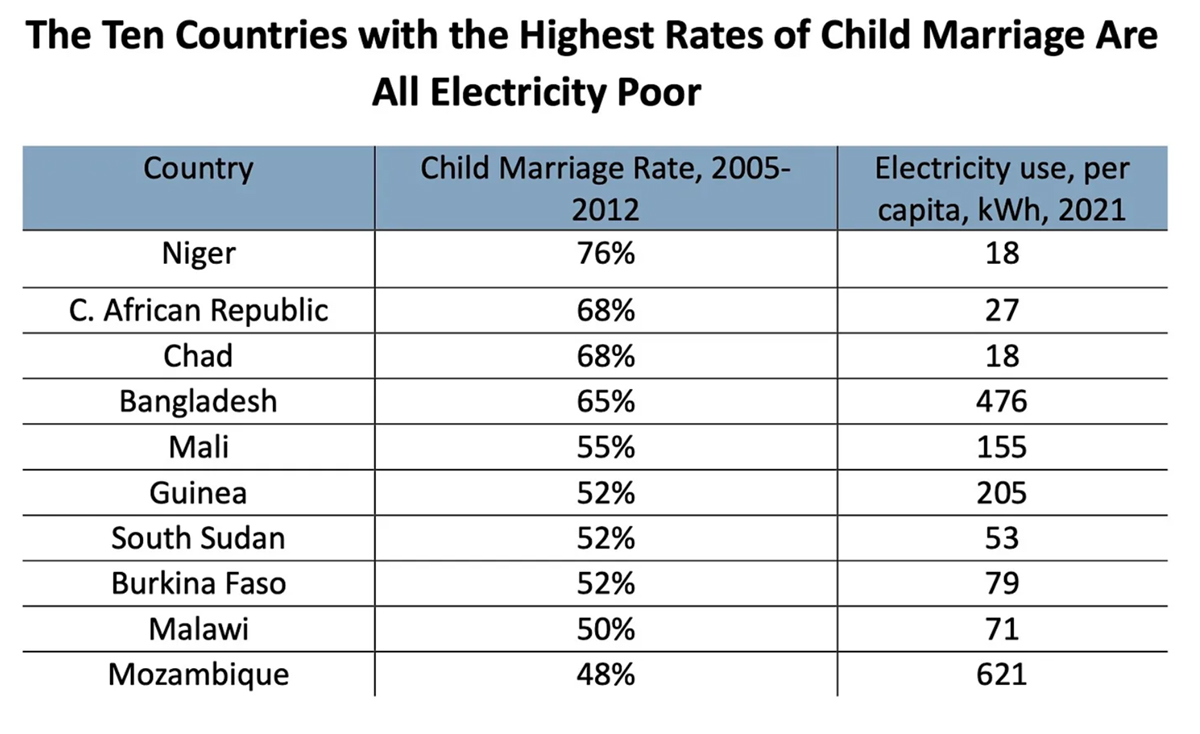
Electricity is essential for all human beings. But it is particularly beneficial for women and girls because it frees them from the drudgery of energy poverty. Put short, electricity emancipates women and girls from the pump, the stove, and the washtub.
Numerous academic studies have shown the positive effect electrification has on women and girls. A 2002 study in Bangladesh by Abul Barkat, an economist at the University of Dhaka, found that the literacy rate for females in villages with electricity was 31% higher than it was in villages that lacked electricity. The study concluded that the availability of electricity has a “significant influence on education, especially on the quality of education. This influence is much more pronounced among the poor and girls in the electrified households than the poor and girls in non-electrified households.”
A 2010 study on post-apartheid electrification in South Africa found that “employment grows in places that get new access to electricity.” This was particularly true for women. The study found that electrification led to “large increases in the use of electric lighting and cooking, and reductions in wood-fuelled cooking over a five-year period, as well as a 9.5 percentage point increase in female employment.”
A 2012 study of rural electrification in India concluded that the availability of electricity had a significant impact on schooling for girls, finding:
“…electrification access increases school enrolment by about 6% for boys and 7.4% for girls. It also increases weekly study time by more than an hour, and the increase is slightly more for girls than boys. As a result of more study hours, children from households with electricity can be expected to perform better than their peers living in households without electricity.”
The same study found that “The impact of electrification on labour supply is positive for both men and women; that is, household access to electricity increases employment hours by more than 17% for women and only 1.5% for men.” Further, the study found that electrification reduces the overall poverty rate by 13.3%, and it concluded that “these findings indicate electrification’s substantial positive effect on overall household welfare.”
Complex studies are not needed to show that extreme shortages of electricity are a common factor in nearly every country where women and girls are vulnerable to illiteracy and child marriage. World Bank data shows that the countries with the highest female illiteracy rates are all in the Unplugged world. If you are a female in an impoverished country and do not have access to electricity, you are, effectively, a slave to the physical chores of the household: hauling water, making fires, grinding grain, and washing clothes. In 2014, the United Nations Children’s Fund released its “State of the World’s Children” report. It is a sobering document that details the plight of children around the world, and in particular, the plight of girls. Among the aspects that UNICEF examined was the issue of child marriage, that is, cases in which girls are married before age 18.
As seen in the graphic above, the 10 countries with the highest rates of child marriage are all in the Unplugged World. Furthermore, among those 10 countries, the rates of child marriage tend to be highest in the places where per capita electricity use is lowest. For instance, in Niger, between 2005 and 2012, according to UNICEF, about 28% of girls were married by the age of 15. By the age of 18, some 76% were married. As seen in the graphic and the Appendix, per capita electricity use in Niger is now about 18 kilowatt-hours per year. In the Central African Republic, electricity use is just 37 kilowatt-hours per capita per year. In Chad, it is 18 kilowatt-hours. In those three countries, the electricity usage rates are so small as to be insignificant. For example, a resident of Chad, who can use just 18 kilowatt-hours of electricity per annum, would, over the course of a year, only have enough power to boil a kettle of water every four days.
Read the rest of this piece at Robert Bryce Substack.
The excerpt above is another installment of the paper I wrote for the Alliance For Responsible Citizenship. It covers the sections on electricity’s importance to women and girls, and why coal continues to be a dominant fuel for power generation around the world. If you want to read the entire report, it’s available here.
Robert Bryce is a Texas-based author, journalist, film producer, and podcaster. His articles have appeared in a myriad of publications including the Wall Street Journal, New York Times, Forbes, Time, Austin Chronicle, and Sydney Morning Herald.
Photo: Zelina Richards, 12, and Florence Richards, 13, washing clothes by hand, Nicholas County, Kentucky, 1916. Library of Congress.













